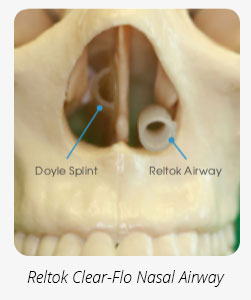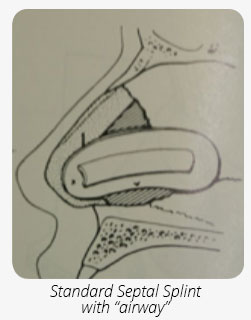The experience cited below is based on 150 cases in which the airway was employed. A clinical study evaluating all aspects of the anatomy, physiology, physics of airflow through a closed space, and clinical performance of the device is available.*
Doctor FAQ
Q: Is the Reltok Clear-Flo™ Nasal Airway System a splint or a stent?
A: The Reltok system comes with both an intranasal airway and septal splints.
- The Reltok Clear-Flo™ Nasal Airway is designed, patented and FDA-cleared as a safety device to serve OR and recovery room staff for rapid and direct access to the pharynx post-operatively. Its exclusive mission is to deliver an improved patient experience after nasal/sinus surgery via clear and open nasal passages for easier breathing.
- The Reltok Ultra-Smooth Septal Splints provide structural support to the septal area after a septoplasty, but are designed to occupy less space within the nasal cavity as compared to similar products. The splints are made of Class VI medical grade silicone with a Parylene coating for a low-fricition surface that allows stents, packing and the Reltok Clear-Flo™ Nasal Airway to glide smoothly and quickly into place and retards secretion adherence.
Q: Any contraindications to using the airway?
A: No. The nasal airway is appropriate to use after rhinoplasty, septoplasty, turbinate and sinus surgeries. For open rhinoplasty cases, in deference to the external transcolumellar incision, the bridge connecting the two tubes can be divided and each tube secured by the suture technique of the surgeon’s choice.
Q: How long can the airway stay in place?
A: The nasal airway tubes are able to stay in the patient for 7 to 10 days post-operatively without any adverse consequences.
Q: Can one use septal splints concomitant with the nasal airway?
A: Yes. Every technique of intranasal splinting, stenting or packing is compatible with the indwelling nasal airway. It was designed that way. The key to internal harmony is that the device is designed so that it nests in the “surgically-quiet” always un-operated portion of the nasal fossa, the floor. The Reltok Clear-Flo™ Nasal Airway enables airflow through the nasal passages without compromising the function of the packing, splinting or other cavity fillers. The system comes with both an airway and septal splints because they are often used concomitantly.
Q: “I don’t routinely pack the nose. Why should I insert an airway?”
A: Packing or no packing, the nasal cavities will fill with blood and mucus. Guaranteed. And there will always be some nasal mucosal edema. This will cause the non-packed patient to be dissatisfied. Since nose-blowing is unwise and generally forbidden in the immediate postoperative period, without a guaranteed airway, the patient will unhappily resort to mouth breathing. The Reltok Clear-Flo™ Nasal Airway is the patient’s best friend after surgery because it provides clear nasal passages and mitigates their anxiety, claustrophobia, clogged ears and dry throat which detract from their satisfaction of a successful surgery. With the airway painlessly in place, the patient is content and appreciates the surgeon’s efforts in providing an optimal post-operative experience..
Q: Any packing material or technique of packing that is incompatible with the airway?
A: No. Absorbable and non-absorbable packing was used in every clinical study case. Packing is an independent issue.
Q: If the nose is packed tightly, can the airway device be compressed and rendered inoperative?
A: No. A specific durometer (measure of stiffness) silicone material was selected to rule out such a possibility. Never happened in the clinical study.
Q: Is it possible for the airway tubes to become blocked by blood or mucus?
A: Yes. It is possible, but correctable. A home irrigation syringe and tip are included in the kit. Patients and caregivers, who assiduously follow the Instructions for Home Care card, will be able to prevent blockage. However, if home care is somehow inadequate, using a suction catheter at an office visit will solve the problem. Our experience was that fewer than 5% of patients required an office visit to clear the nasal airway device.
Q: Can the airway dislodge anteriorly? Posteriorly?
A: The “bridge” prevents any posterior migration. In our experience, no airway ever self-extruded, anteriorly for two reasons:
1. The airway is designed to fit snuggly onto the floor of the nose.
2. The act of swallowing tends to create a posteriorly-directed, negative intranasal pressure that mitigates against any anterior movement.
Q: Any worries about the tubes “sticking” to intranasal tissue and causing problems in removal?
A: Never a problem with removal because medical-grade silicone is the classic non-stick material. Artificial heart valves and joints are made of the same material. Even SuperGlue® will not stick to it.
Q: Is removal painful?
A: No. However, if you want to allay any patient anxiety, topically anesthetize the nose five minutes prior to removal. Here’s what works for us: a 1:1 mixture of oxymetazoline 0.05 %, or phenylephrine 1%, with pontocaine 2%. This renders the nose anesthetic and shrinks the mucosa to help facilitate removal. Drip into nasal cavity and wait five minutes. Repeat if you like. Then remove the airway device and, as indicated, the packing. Another tip: For those patients raised on tales of the horrors of nasal pack removal, plan a pre-medication sedative routine. A dose of a tranquilizer and pain pill, of surgeon choice, taken one hour prior to pack removal and secretion suctioning will bring a less anxious patient to the office.
Q: Does the surgery center and/or hospital purchase the Reltok Clear-Flo™ Nasal Airway System?
A: Yes; analogous to supplying the anesthesiologist with endotracheal tubes. The facility is responsible for supplying the surgeon with all supplies, materials, and devices used in the OR. All consumables should be line-item billed by the facility to the insurer. Your medical biller or coder will know how to submit the charge.
Q: Will insurers compensate the surgeon for the additional service of inserting, positioning, and later removal of the airway?
A: Yes. Because the Reltok Clear-Flo™ Nasal Airway was designed, patented and FDA-cleared as a safety device to serve OR and recovery room staff for rapid and direct access to the pharynx post-operatively, nasal surgeons have the right to charge a fee—in addition to the surgical procedure fee—for the additional professional service of inserting and later removing it. This nasal airway is not a pack; it is not a splint; it is not a stent. The airway is not being used to influence the outcome of the surgery, as the splints and stents are used. There is an established CPT billing code (30999- by report). Each surgeon will, of course, create a custom operative report for the surgical case. In any event, the above-mentioned procedure code should be accompanied by a descriptive title such as “insertion intranasal airway” or “prosthesis”. Allowances and actual payments, of course, vary depending on policy benefits, deductibles, co-pays, etc.
Q: Can these airway tubes be reused?
A: No. The Reltok Clear-Flo™ Nasal Airway and Ultra-Smooth Septal Splints are single use, sterile products. Federal law prohibits reusing these products.
MD Objections, Concerns, and Responses
“I don’t pack…”
The Reltok Clear-Flo™ Nasal Airway was invented to provide a clear breathing channel with or without packing, stents or splints in place. “Not packing “may be what patients want to hear, because of the universal bad press about not breathing when the nose is packed. The Reltok Clear-Flo™ Nasal Airway has only one mission which is to provide patient comfort via satisfactory air passage through the nose. No other device can achieve what this airway can do for patients.
The reality is that “not packing” is not synonymous with clear breathing. There is mucus stagnation, some blood accumulation, edema and these cause blockages. Patients are advised not to blow their nose. And suggesting that they do home irrigations without medical supervision, adds some uncertainty. Another reality is that attempts with at home flushing to clear the crusty and thickened-secretions to re-establish satisfactory breathing is rarely successful.
Better to know there has been a deliberate pro-active maneuver, an airway placement, at the conclusion of the operation, to provide a device that works and eliminates the uncertainty and the risk of some interference with healing when self-irrigation is the only remedy prescribed. Surgeons that place the airway and pack are happy for another reason: the packing provides moisture retention and thus promotes more rapid healing. They report that when they remove the airway and pack at 4 to 7 days, the inside of the nose is moist, pristine and without crusts and free of unwanted contact between adjacent tissues, e.g. septum and turbinates.
“I use the Doyle splint…”
Fine. Are you using it as a septal splint? Or ostensibly as an airway, also? The septal splint or plate is good, however, the attached “airway” does not work. No secret there. The Reltok Clear-Flo™ Nasal Airway System offers the “best of both worlds” for you as the surgeon and your patients. An advanced septal splint design without the cumbersome and functionless ® air tube attachment and a proven airway that works is what customers receive with the Reltok Clear-Flo™ Nasal Airway System. Plus, nasal surgeons have the right to charge a fee—in addition to the surgical procedure fee—for the additional professional service of inserting and later removing the nasal airway.
“I admit that the Doyle-type splint clogs, so won’t the Clear-Flo Nasal Airway clog also?”
The Doyle splint clogs and itself contributes to obstruction within the even-unpacked nasal passages. Here is a comment from an experienced practitioner in New Jersey:
“I do embrace the concept of a patient airway during insertion of a packing or stenting device. My patients do complain of total nasal obstruction while the Doyles are in place…”


“I don’t believe insurance will pay me…”
We understand your skepticism because it is an unusual circumstance. Because the Reltok Clear-Flo™ Nasal Airway was designed, patented and FDA-cleared as a safety device to serve OR and recovery room staff for rapid and direct access to the pharynx post-operatively, nasal surgeons have the right to charge a fee—in addition to the surgical procedure fee—for the additional professional service of inserting and later removing it. This nasal airway is not a pack; it is not a splint; it is not a stent. The airway is not being used to influence the outcome of the surgery, as the splints and stents are used. There is an established CPT billing code (30999- by report). Each surgeon will, of course, create a custom operative report for the surgical case. We can provide you with copies of Explanations of Benefits from all the major carriers to confirm that, yes, you are entitled to be paid for this important service to your patients.



